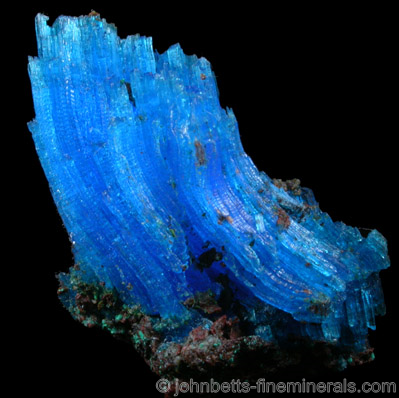The Mineral chalcanthite

Natural Chalcanthite crystals are very rare in nature. Well-formed
crystals are easily grown synthetically from copper sulfate solutions. This can be done by dissolving a readily
available chemical salt called copper sulfate, and then letting the water evaporate. This leaves behind a crystallized
mass of Chalcanthite which can crystallize beautifully if grown properly. If a Chalcanthite crystal looks to good to be natural, it
probably is, as good natural crystals are very hard to come accross. Unscrupulous mineral dealers have been known to sell large, synthetic
Chalcanthite specimens without indicating that they are not natural.
Chalcanthite generally forms in arid regions and dry caves which are protected from moisture. It commonly forms stalactitic and botryoidal growths on the walls and ceilings of mine tunnels from the oxidation of copper sulfide minerals.
Chalcanthite specimens must be kept away from water and moist conditions, since a chemical effect with water causes them to eventually crumble or dissolve. Some collectors specimens are coated with mineral oil and sprayed with laquer to seal the mineral and prevent it from absorbing water. Chalcanthite is a very fragile mineral, and care should be taken when handling any specimen.
The name Chalcanthite is derived from the Greek words "chalkos", which means copper and "anthos", flower, describing the curved and sometimes flowering formations of this mineral.
Chemical Formula
CuSO4 · 5H2O
Color
Bright blue, sky-blue, greenish-blue
Properties
Streak
White |
Hardness
2.5 |
Transparency
Translucent |
Specific Gravity
2.3 |
Luster
Vitreous, silky, dull |
Cleavage
Indiscernible |
Fracture
Conchoidal to splintery |
Tenacity
Brittle, thin projections slightly flexible |
Other ID Marks
1) Has a sweetish, metallic taste. (Note of caution: Chalcanthite is poisonous and should not be taste-tested, unless the lick is minor and it is spit out and rinsed immediately.)
2) Dissolves slowly in water, turning the solution blue. |
Crystal Habits
Crystals, which are rare in nature, are in short prismatic form and in thick tabular crystals. Most often as fibrous veins, which are commonly curved, and as and flowering curved masses of parallel fibrous crystals. Also botryoidal, stalactitic, encrusting, massive, as tiny, slender needles, and lenticular.
Uses
Chalcanthite is an important ore of copper in areas where it occurs in relative abundance, such as in Chile and Spain. It is also used as a root killer in sewer pipes by flushing Chalcanthite pellets down the toilet. Specimens are popular among collectors, and the synthetically grown crystals are often sold to unwary collectors.
Noteworthy Localities
In Chuquicamata and El Teniente in Chile, large, fibrous Chalcanthite masses occur in abundance and are mined as an ore of copper. A sizable deposit also exists in Minas de Riotinto, Andalusia, Spain.
Also comes from the Sao Domingos Mine, Portugal; and Lubin, Legnics, Poland. Large botryoidal crusts were found Tsumeb, Namibia.
In the U.S., the most prominent locality for Chalcanthite specimens is the Planet Mine, La Paz Co., Arizona. Other Arizona occurrences include Bisbee, Cochise Co.; Ajo and Tiger, Pinal Co.; Globe, Gila Co.; Morenci, Greenlee Co; and the Patagonia District, Santa Cruz Co. Also occurs in Bingham Canyon, Salt Lake Co., Utah; and Ducktown, Polk Co., Tennessee.
Distingushing Similar Minerals
Few other minerals have the rich blue color and forms, making Chalcanthite hard to confuse with other minerals.